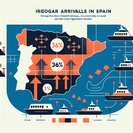
Spain’s position as an immigration heavyweight was cemented on 5 November when Spanish media digested the newly-released OECD International Migration Outlook 2025. The report shows Spain admitted 368,000 new permanent immigrants in 2024—almost 50 % above pre-pandemic levels and enough to rank fifth in the 38-member OECD behind the United States, Germany, Canada and the United Kingdom. More than half of the inflow came through family and free-movement channels, while labour and humanitarian admissions accounted for roughly 11 %.
Behind the headline number lies a profound shift in the country’s labour market. The Independent Fiscal Authority (AIReF) estimates that immigration has generated 190,000 new households since 2022, directly fuelling consumer demand and explaining nearly half of Spain’s growth premium over the euro-area. Sectors such as healthcare, construction and agriculture—facing chronic labour shortages as Spain’s population ages—have been the main beneficiaries. The OECD warns, however, that demographic tailwinds could fade as early as 2026 if housing costs continue to climb and EU recovery funds wind down.
For policy-makers the message is clear: consolidate recent regulatory reforms, speed up recognition of foreign qualifications and expand training so newcomers can move quickly into skilled jobs. Spain’s May 2025 overhaul of its Immigration Regulation—streamlining permit renewals, extending job-seeker visas to 12 months and creating five new regularisation pathways—was singled out by the OECD as a model for flexible, labour-oriented migration management. Yet analysts caution that integration bottlenecks remain, particularly in social housing and regional diploma-validation offices.
![OECD Migration Outlook places Spain in global top-5 after record 368,000 arrivals]()
For employers, the numbers underscore why proactive talent strategies are essential. Multinationals already operating in Spain should audit workforce-planning assumptions: a tighter supply of domestic workers may resurface after 2026, making continued reliance on international recruitment, intra-company transfers and fast-track permits under the Entrepreneurs’ Law indispensable. HR teams are advised to monitor upcoming ministerial orders that will translate the new regulation into province-level procedures by early 2026.
For globally-mobile professionals, Spain’s appeal is multidimensional—temperate climate, competitive cost of living and an increasingly agile visa ecosystem. But capacity constraints are emerging: some immigration offices in Madrid and Barcelona report appointment backlogs of six to eight weeks. Companies should therefore build extra lead time into assignment planning and consider secondary cities—Valencia, Málaga, Bilbao—where processing is faster and regional governments offer relocation incentives.
In short, Spain’s demographic story is no longer about emigration; it is about harnessing one of Europe’s largest and most diverse immigrant workforces to keep growth on course. Whether the country succeeds will depend on the next wave of integration and labour-market reforms now being drafted in Madrid.
Behind the headline number lies a profound shift in the country’s labour market. The Independent Fiscal Authority (AIReF) estimates that immigration has generated 190,000 new households since 2022, directly fuelling consumer demand and explaining nearly half of Spain’s growth premium over the euro-area. Sectors such as healthcare, construction and agriculture—facing chronic labour shortages as Spain’s population ages—have been the main beneficiaries. The OECD warns, however, that demographic tailwinds could fade as early as 2026 if housing costs continue to climb and EU recovery funds wind down.
For policy-makers the message is clear: consolidate recent regulatory reforms, speed up recognition of foreign qualifications and expand training so newcomers can move quickly into skilled jobs. Spain’s May 2025 overhaul of its Immigration Regulation—streamlining permit renewals, extending job-seeker visas to 12 months and creating five new regularisation pathways—was singled out by the OECD as a model for flexible, labour-oriented migration management. Yet analysts caution that integration bottlenecks remain, particularly in social housing and regional diploma-validation offices.

For employers, the numbers underscore why proactive talent strategies are essential. Multinationals already operating in Spain should audit workforce-planning assumptions: a tighter supply of domestic workers may resurface after 2026, making continued reliance on international recruitment, intra-company transfers and fast-track permits under the Entrepreneurs’ Law indispensable. HR teams are advised to monitor upcoming ministerial orders that will translate the new regulation into province-level procedures by early 2026.
For globally-mobile professionals, Spain’s appeal is multidimensional—temperate climate, competitive cost of living and an increasingly agile visa ecosystem. But capacity constraints are emerging: some immigration offices in Madrid and Barcelona report appointment backlogs of six to eight weeks. Companies should therefore build extra lead time into assignment planning and consider secondary cities—Valencia, Málaga, Bilbao—where processing is faster and regional governments offer relocation incentives.
In short, Spain’s demographic story is no longer about emigration; it is about harnessing one of Europe’s largest and most diverse immigrant workforces to keep growth on course. Whether the country succeeds will depend on the next wave of integration and labour-market reforms now being drafted in Madrid.









